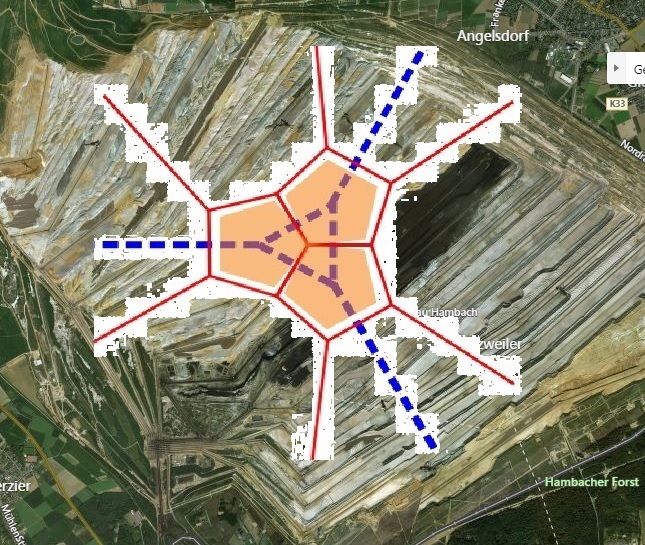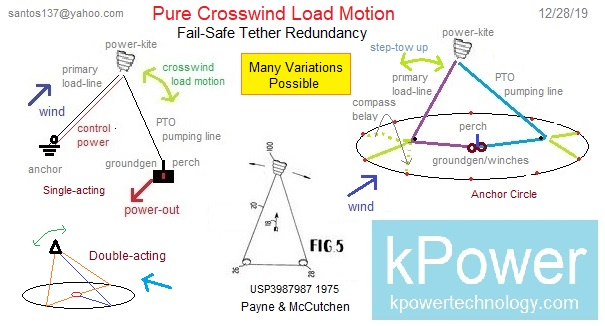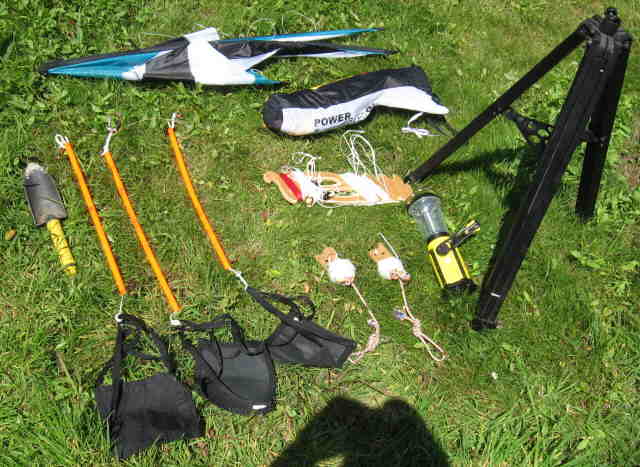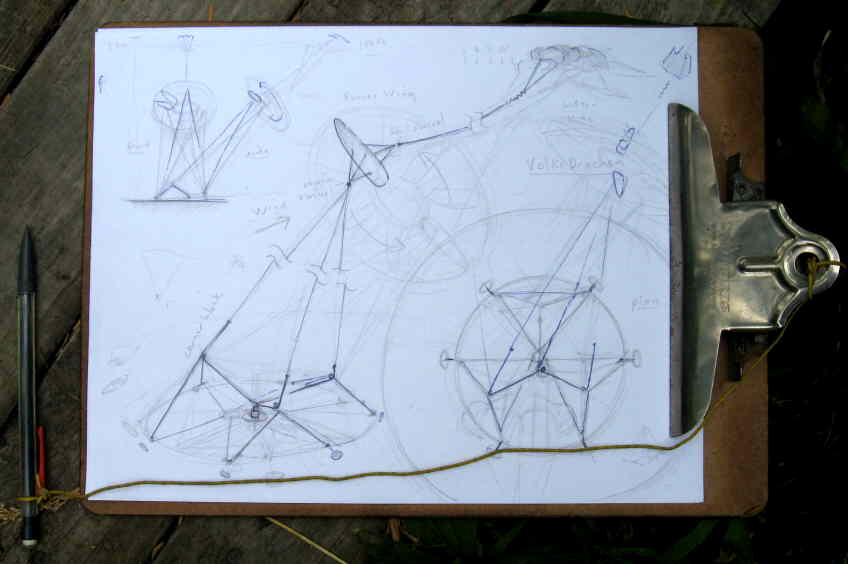- KiteLab Videos
- Passive Sustained Power-Kite Looping
- ed sapir of kPower video channel
- ESC :: electronic speed control or electronic speed controller wiki/Electronic_speed_control
- kPower's conception of converting legacy power plants to
AWES kite hybrids:
- Backdriving Power-Plant Generators as Kite-Array Circle-Tow Motors
- Latest 3r Variation: Legacy Power Plant Reuse
- v
| Send AWE notes and topic replies to editor@upperwindpower.com |
=====================
• How much more energy can be extracted due to higher winds at altitudes viable for AWE, compared to conventional wind?
>100x Its not just the cubic increase in power with velocity, but also the far greater frontal airspace, and the potential to operate high above low-level terrain unsuited for conventional wind.
• How are the winds at higher altitudes characterized over the U.S. – are they overlapping or complementary with conventional wind, what is the spatial distribution of the wind resource, and its temporal variability?
Generally, AWE has a greater potential distribution, but is favored similarly to conventional wind to regions with better wind resource.
• In what way do the characteristics of the wind resource have the potential to boost AWE in the U.S.? Do they have an impact on technical and design aspects of kites?
The US has some of the best wind resource in the world ("Saudi Arabia of Wind"). Kites are designed to wind velocities present.
• What are the key capability gaps to complete the research and development path?
Safely and quickly refining and scaling up proven prototype designs under Optimal Experimental Design. This entails a constant fly-off dynamic at ever increasing scales at shared test sites. Extreme-scale exaflop simulation (ie ExaWind) to look ahead of tested validation.
• What setback distances are most appropriate from a social and technical perspective? E.g., setbacks from residences, transmission lines, radar towers, airports, roads, and viewshed considerations.
Setback is primarily a function of AWES topology and geometry. Large single-line units are prone to breakaway and dangerous sustained tether dragging (Valkenburg Mishap). High-mass high-velocity high L/D units have catastrophic crash potential over great distances. Multiline networked AWES are generally safe just beyond the scope of their tethers. Someday AWEs will operate safely over populations, just as other forms of aviation do. Viewshed concerns seem negligible, given the light surface footprint and quiet low-visibility potential, even with FAA conspicuity compliance.
• What are the technical ocean depth limits of AWE?
No depth limits. Sky-kites can operate opposed to sea-kites (hydrofoils, paravanes) and keep station or even advance to windward.
• What locations might preclude development or prove difficult for permitting due to sensitive ecology and wildlife, e.g., federal lands, bird migration routes, protected lands, and what research might be needed to assess potential impact?
Protected Federal Wilderness could be set aside without significant loss of opportunity. Birds, Bats, and Butterflies are generally not threatened by conventional power-kites at inherent low velocity, but similarly threatened by rigid wings moving at HAWT blade-tip velocites.
• Are there locations that could be prioritized for AWE deployment? E.g., near existing wind or solar power plants, or proximity to existing transmission infrastructure.
Remote high wind sites near Research Universities near and grid access around Laramie, WY, Lubbock, TX, Columbia River Gorge, WA, Mojave Desert, CA, and Corpus Christi, TX. Fayette Coal Plant owned by Austin Energy could be an ideal test site for "Coal-to-Kite" Hybrid Plant testing.
• Are the power curves in Figure 1 realistic and representative of future technologies?
No. They are unrealistic regarding rigid wings and not ambitious enough regarding Kite Networks Plant Scaling.
• Would you propose any major changes to cut-in, cut-out, rated power, or the region 2/region 3 shapes of the curves?
(see marked-up diagram below)




Maximal reuse retrofit of legacy fossil plants, plant airspace set-asides, legacy grid, strip-mines, etc.
Less footprint for more power than Conventional Wind.
• Does AWE offer additional value opportunities in addition to cost savings relative to conventional wind, such as reduced reliance on expensive and scarce cranes or installation vessels?
AWE is a distinct technology with almost no direct equivalences to conventional wind dependencies. No cranes nor highway load-length issues. A huge "Additional Value Opportunity" is direct mechanical work like Pumped-Hydro, irrigation, dredging seawalls or direct powering of Reverse Osmosis Desalination, avoiding electrical capital infrastructure costs and conversion losses.
• What are the key risks associated with AWE technology, permitting, and deployment? Can these risks be mitigated by future R&D investment, stakeholder outreach, or other methods?
The key risk is Safety Liability and Insurability. Existing Aviation and Civil Engineering culture and standards apply. There are no shortcuts.
• Is AWE better suited to commercial (hundred-megawatt) scale deployment or specific markets?
AWE is suited to all scales of energy, from personal (a few watts) to civilizational (TWs). Besides Utility Power, there will be direct kinetic work and distributed power markets. Kite Sports is already a thriving specific market, displacing power demand from waterski boats and ski-lifts .
• Under what conditions would a developer select an airborne turbine instead of a conventional turbine?
At COTS TRL9; Less capital cost, faster deployment, less bird-bat-butterfly impact, more scalable, jobs, etc.
Simple supply chains for Low-Complexity AWE. Many great jobs "sailing in the sky".
• What are the critical technology development challenges – dependent on the different application/market segments?
Operational mastery across a segments. Training.
• What are the key performance indicators and attributes to assess the technology development status?
MTBCF >100khr (Mean Time Between Critical Failure)
GW Plant-scale
• What is the technology development status regarding readiness, performance, and reliability?
Power Kite is COTS TRL9 TPL9 in Kite Sports and Ship Kite apps. Kite Networks based on these power-kite unit-kite derivatives are low TRL and require intensive R&D.
• What are the key capability gaps to complete the research and development path towards market entry – dependent on the different application/market segments.
Extreme Scale Actuator-PTOs (Power Take-Offs) need to be developed. Electrical and Hydraulic Concepts are underway.
• What are the key areas of research or assistance in addressing deployment challenges needed to enable deployment and reduce the cost of energy from AWE?
Massive operational research. Millions of test hours in parallel.
• How can different concepts and scales address the following considerations? The scales, controls, design codes, social acceptance, airspace, scaled device demonstrations, investment, market opportunity topics that are key?
Kite Networks- GW Plant Power, Controls- Pilot-Supervised Passive-Dynamic Autonomy, Design Codes- AWES ISO Code, Social acceptance- Wild popularity, Airspace- Shared NextGen, Extreme-Scaled Demonstrations- International Collaborations, Investment and Market Opportunity- Massive Public Investment, Regulated PPP opportunity.
• What are the highest priorities and next steps for commercialization of AWE technologies from the standpoint of technology developers and project developers?
Global Optimal Experimental Design on a Manhattan Project Scale, not premature market chasing by oversold unqualified ventures.
• Rank the barriers to AWE’s becoming a significant source of electricity to the U.S. starting with 1 (greatest barrier) to 10 (lowest barrier)
1) Scalability and Safety-Reliability 10) (Air-to-Ground Transmission, Control Systems, Electric generators, Government regulation, Grid Integration, Land Use, Operating Costs, Tethers)
• Which technology market(s) are you aiming for and what do you expect the total technical development costs to be before market entry as commercial product?
kPower aims at Civilizational Power (10TW). R&D of maximal scaling will spin-off AWES at each increasing scales. Personal scale AWES are already COTS TRL8-9
• What R&D investments are needed to bring AWE technologies to commercialization?
Direct global Climate Change repowering investment into urgent AWE R&D, proportional to merits. Investment in Polymer Fiber and Roll-stock Production to match requirements.
New Power-Kite variants, Kite Networks, and fundamental Multi-Physics (theory and simulation)
and
We could not interest early Cablecam in 1:1 small-scale AWE R&D, with their winches.
KiteLab Ilwaco had pioneered 3r AWES in 2009, so it was gratifying that TUK provided independent third-party concept validation, if a decade later. We also did first 3r persistent-flight demos at AKA Windless Kite Festival. Forgive us for racing to beat Google for world-first self-flying groundgen (kitemotor1 2007). Our classic kite autonomy basis was identified as a Quantum Computing analogue. Joe and I were invited to write a bit in Physics World, and our kite-QM analogy passed review there, and with various other physicists. kPower came to see in 3r a "kitematter" metamaterial unit-cell lattice basis at aggregated GW scale, and TUK and ASU are on that.
Austin has long complex relation with Bay Area. O-Reilly's Maker brand was a clone of Silicon Barrio and Robofest, which I founded. We gave them permission to copy the format as Maker Faire. Mark Pauline's SRL was our affinity partner, and I hosted him in Austin. Dave Culp brought me to Alameda for KiteShip, as we had long known each other via his Speed Sailing circle (along with Peter Lynn Sr.). DaveC helped found kPower of Austin in 2007, as KiteShip was swallowed up. Obviously, we are the KIS "low-complexity" school in AWE.
Hoping OtherLab, and other Bay Area AWE players, still have game in AWE. The Pacific NW is a major R&D hub, starting with the Roeselers developing KiteSurfing and visionary Wayne German pushing AWE at Boeing MoF, plus many other small merit players, and we are trying to get an AWEC2021SeaTac event agreed with the struggling AWEurope VCs. We are lining up the ducks for BEV funding for a worldwide R&D fly-off research design under Fraunhofer Society coordination. TUK is key to that.
kPower's SpaceX deep-operative, Pete Murray
kPower's SpaceX deep operative, Pete Murray, from a 2013 a Texas AWE Encampment Report Draft. Pete is my direct youth apprentice, a brilliant humanist who became an engineer despite being written off by an elite critic. SpaceX planning to colonize Mars from South Texas Spaceport. Very proud of Pete's amazing journey-
"Yesterday we had a strong Cold Front pass thru Austin, with winds gusting to 45mph. The turbulence of these characteristic events are almost unflyable, but we managed to "test" (play with) a range of flipwings, a New Tech Kinetic Kite, and one of Shawn's Moon Kites (classic Carribean kite evolved for high wind).
We are making the rounds of local shops and experts, activating a sort of dream team for pending experiments. Let the roster of talent be a later note.
This weekend is the first field-trip out of town, for the Waco Kite Festival, where WhataKite, the giant-kite specialists, will be the featured flyers. Our crew will get more hands-on as helpers ("kite-buddies"). We hope to convince Barry to commission a world-record largest kite made by Mothra tech :)
Two of our circle work for new rocket companies (Pete Murray with SpaceX and Chalo with Blue Origin. Pete is based at SpaceX. [[See Tesla]]
Paolo had to postpone his visit due to a minor emergency, but is rescheduling."
EV KiteBoard excels as "KiteFarm Buddy"
Today the EV kiteboard proved itself in a new role, as a kite field mobility tool.
kPower was flying a 22m2 Peter Lynn Pilot-Lifter about 100m high at Dripping Springs. Ending the session, the kite was "walked down" with a snatch-block by EV skateboard. This would have been harder and/or more expensive with other vehicles that all require hand-steering. The EV board was ideal.
When AWES come to routinely operate with km long tethers on km scaled fields, EV skateboards will prove quite handy for efficient operations, whenever a larger EV is not required (like massive anchor or tow vehicles).
======================================
And:
And added note:
This is a generic ground-gen topic, beyond the cool VESC product, that is just one of several fine ESC lineages.
Seeing Electric Mountain Boards trending strongly in the last year. These are inherently kite-worthy. Its just like kite-skiing does not need a mountain.
Kite and wind is curiously a mountain-substitute, yet again.
[Ed adds: https://trampaboards.com/ ]
Kite EV Skateboard ESC "Cruise Control" (salivation warning)
It is a busy job to fly a kite and navigate an EV at the same time. Not only do both systems typically have to be steered, but power-supply and load-demand balance needs to be managed. Maintaining velocity in dynamic conditions, fiddling between motoring, coasting regen modes, becomes a chore.
Now your EV skateboard can have cruise control like a Tesla. The system manages the ESC throttle-function to maintain a constant EV velocity. Kite and terrain can vary, but Cruise Control promises to even it all out. A big step toward full automation.
=========================================================AND
April 28, 2020, post by Dave Santos
VESC (popular motor-regen controller)
EV Skateboard OEMs, Kitewinder, and Team Tuddle use VESC. Its not the only such motor-regen ESC line, but one of the best-
VEDDER ELECTRONIC SPEED CONTROLLERS - Presented by TRAMPA
KPower's AWE Documentary and other hidden actions
Progress E Skateboard
Relentless kPower progress. Still refining geometry and details. Lots of great crosswind pumping, but this is the only usable footage that the random children videoing managed. Mom emailed clip. kPower expensed ice cream for all, which Google was always too cheap to pay for.
Pending rig for Zilker Kite Fest will nail it.
kPower invited speaker to TX Rotary International Club
By a curious chance, a Rotary International Monday-scheduled speaker on US Census cancelled, and I am invited on two-day notice to present instead on Kite Energy. Have always known these folks to be super friendly, so will be great fun to share AWE. Will report afterwards,
Review of Rotary reveals an admirable creed and history. Rotary International
Cool demo!
Charge
Electric Vehicle Skateboard by Historic Patent Arrangement
------------------------------------
Testing the Kiteboard EV further, session by session. Some key lessons are not as much kite-related as EV-related.
In the context of Polar KiteSled EV R&D, lower winter temperatures have caused noticeable reduction in Kiteboard EV battery performance. Literature study details the operational issues Polar EVs face. Its attractive to combine battery thermal management with a nomadic EV crew’s cabin space heat requirement. The same thermal regime applies to stationary AWES batteries in cold conditions.
Tesla batteries use a dedicated heating system. There are specialty batteries with somewhat better cold performance chemistries, but some preheating would still be wanted in Polar cold-
https://relionbattery.com/low-temperature-series-line 1=====================
Here is final updated prototype design based on testing. The upper loadpath bridle needs to be long enough to avoid pinching the wing laterally. As originally rigged, the NPW nose tended to collapse during surge. The Control Bar worked well enough, but some tunability with a Dan Tracy bar would be handy on some less-used “points-of-sail”. Integrating the EV throttle and settings buttons into the bar would be a final refinement. The regen braking could use a settable input. More EV charge instrumentation would be helpful. I may soon be trading this EV for a used paraglider and harness, as the safer activity :).Feb: 2020:
Because of wrongful moderation restrictions on my account, I could not post any more on fig5 topic, so posting here, as the EV skateboard regen capability is involved.
The latest twist is that common regen is not automatic in back and forth pumping, but the ESC must flip between forward and reverse for two way regen. A robot hand to operate the ESC control logic would be cool.
Video clip shows typically relentless kPower testing progress, by many modest steps, over many years. Still refining geometry and details. In an almost infinite design space, converging on optimality is slow but wondrous.
Lots of great crosswind pumping now, but this is the only usable footage that the random children videoing today managed. Mom emailed kPower the clip. kPower expensed ice cream for all (which Google was too cheap to pay for; they are not even in AWE any more, citing cost).
Fig5 full rig for Austin Zilker Kite Fest next month should be in the sweet spot.
Seeing SkySails Flexpower Unit as first COTS basis to rig AWES like these below. kPower has validated the essentials with years of small-scale prototypes, and continues to refine details, like a passive kite-kill if any leg is cut. We can operate without control-pods, comm-links, RATs, or conductive tethers.
Our conviction is that single line AWES and power-kite operations over people and property are uninsurable under current failure statistics, and that rigs like those below are the golden way forward.
Please let us know what you think.

kPower noted in featured startups
10 Delft-based startups to keep an eye on in 2019 and beyond
By Bojana Trajkovska -November 15, 2019
Re: kPower Schematic for Expeditionary Kite-Electric Skateboard
kPower reports a successful maiden flight of the Kite-Electric Expeditionary Skateboard earlier today at Oak Springs soccer fields in East Austin, Texas. Rigging the system as shown in the schematic, from 100% COTS components, only took 3 hours the first time, to be done in <30 minutes with practice.
There was a bit of a line snarl at first, that cleared nicely. It was tricky handling both the skateboard's loose remote control, to engage regenerative braking, while kite flying by control bar, but it all worked; and will only get better. It was not practical to take video with hands so full, await catch-up media soon. Each follow-on session will vary and refine the rig toward ideal proportions and features.
A 70km round-trip along Mustang Island, on the Texas Coast, is hoped this weekend.
Re: kPower Schematic for Expeditionary Kite-Electric Skateboard
Angela reminded us of our former conception of having a kiteboard with impeller-driven generator. So, combine the land skateboard as sea-going kiteboard. Use same battery pack and generator; just transfer from wheel drive to impeller drive. Cross roaded lands and water bodies!
The water arrangement would need a more robust packing to face the corrosive effects of waters. And the family of such devices faces also kite cars and kite boats with the generative aspects. The aircraft cousins have RATS (ram-air turbines).
kPower
[See: RegenerativeChargingDoneSlow.html for preamble message.]
kPower Schematic for Expeditionary Kite-Electric Skateboard
kPower now has all components in-hand, and is rigging the board as shown-





